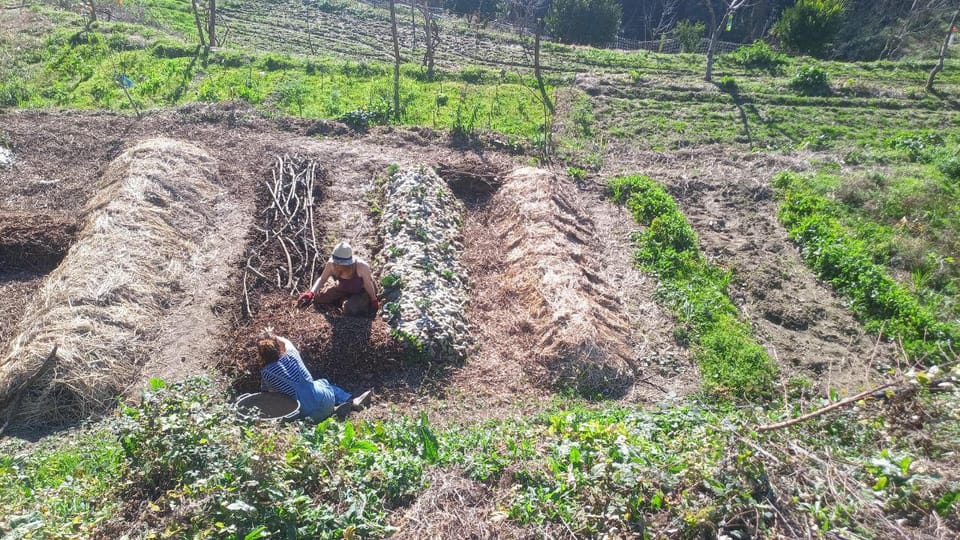An Introduction to Permaculture

I was first introduced to Permaculture at a farm located in Calabria, Italy, where I lived and volunteered. I've always been interested in gardening and keen to learn. Through the WWOOF program (World Wide Organization of Organic Farming), I connected with a small homestead willing to host me for a couple of months. This opportunity seemed to align with my interests. The work was hard but wonderfully fulfilling.
There was still frost on the ground as I gathered branches below newly pruned citrus trees. My fingers numb as I bound the bunches in twine, stacking them to dry for the years to come. The amenities were limited—a single solar panel being our only source of electricity. But that's all we needed. I stayed warm by the kitchen fire. Smiles and stories from newly met friends kept me company. The aromatics of lemon tea fill the small hay hut, where we eagerly await a warm meal. Nothing is more delicious than fresh homegrown vegetables. Even the boiled leafy stalks of artichokes never seemed to disappoint.
Since then, I have been working in pursuit of a career based around permaculture. There is an opportunity for global change within these methods. And I refuse to see past it. This subject endlessly fascinates me. And I hope to share with you the joy it brings me.
Permaculture was a term created by Bill Mollison, Standing for permanent agriculture. It aims to create agricultural ecosystems that are self-sufficient and regenerative. He and David Holmgren Created the textbook Permaculture: A Designers' Manual. It presents an agricultural design strategy. The text is philosophical and addresses the responsibilities of humankind. Suggesting ways to live with nature rather than against it, harmonizing human activity with the environment.
When creating sustainable and regenerative sites, we deeply examine where energy lies. By fully comprehending available opportunities, we empower ourselves to make good decisions and create solutions. We often consider "closed-looped" systems, where energy is saved rather than wasted. Energy manifests in various forms, from wind and biomass to the potential energy stored in water on a hill. We can truly optimize our designs through a thorough grasp of the energy dynamics within a site.
The book Permaculture: A Designer's Manual states, "Organized systems drift inevitably towards Entropy or chaos. In seeming violation of that, biological systems tend to become increasingly complex and efficient." Diverse and Interconnected systems result in increased yields, less labor, and resilience. If one system component fails, it will still function and thrive.
Permaculture can be applied in many situations, from small patios or urban gardens to large desert plots. It is also extremely important in the regeneration of land affected by desertification due to "conventional farming." The modern development of agriculture kills the microbiome in soil. Plants have symbiotic relationships with microorganisms, and consistent tilling and chemical use is unsustainable for life. Leaving large areas of soil dry and barren. The permaculture approach presents alternative methods that prioritize soil health. In doing so, sequestering carbon from the atmostfear and benefiting the endemic wildlife.
Permaculture, as a design system, does not introduce anything entirely new. Instead, it organizes a wide array of ancient and contemporary practices in a manner that conserves energy or generates more energy than consumed. Many methods are credited to First Nations peoples around the world.
There are three primary Permaculture ethics. Care for Earth, Care for People, and Fair Shairs. The second and third ethics ultimately arise from the first, Care for Earth. By prioritizing our ecosystem, it will provide for our needs. Giving us the ability to extend care to our community. Along with these ethics, we also consider these permaculture principles when making design decisions. Observe and interact, catch and store energy, obtain a yield, apply self-regulation and accept feedback, use and value renewable resources and services, produce no waste, design from patterns to details, integrate rather than segregate, use small and slow solutions, use and value diversity, use edges and value the marginal, creatively use and respond to change.
This design approach is convenient and bountiful. When designing, we also examine many personal factors, planning extensively for optimal practicality. We consider things like access to resources, time, budget, skill set, community, and much more. This information is crucial when developing a realistic plan that works for you.
Releasing as much land as possible for the sole use of our native species and respecting all life forms is a fundamental ethic for humankind. Small changes can absolutely make a difference to our climate. We should not let the looming threat of global warming hold us back. We must act. With this approach, it can be easy to take the first steps.


